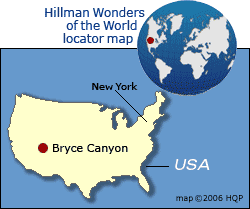Bryce Canyon
 Why
Bryce Canyon
is special
Why
Bryce Canyon
is speciallandscape bursting with colorful, unique bizarre-shaped rock formations. They come in many guises, including soaring fins and towering spires (nicknamed "hoodoos"). They proudly stand erect in huge natural depressions called amphitheaters.
Bryce Canyon tips and insights
When to come
May to mid-June and September to mid-October are ideal times to visit. The rest of the summer period can be overly packed with tourists. During the peak season, parking spaces at the lookouts become scarce. Do your sightseeing early or late in the day, or use the shuttle bus. Being at a viewpoint early in the morning or late in the afternoon has another advantage. The low-angled sun rays enrich the colors of the rocks.
Layout
Bryce Canyon is long and narrow, with a north-south orientation. The 30-kilometer (18-mile) main park road runs along its western rim.
Lookouts
There are over a dozen lookouts. The best are in the north (Sunrise, Sunset, Inspiration and Bryce).
Views
On a clear day, you can see terrain over 150 kilometers (90 miles) away. At night, it's a stargazer's dream, thanks to the isolated location, the exceptionally clean air, and the 2400 meter (8000 feet) altitude.
Trails
Hikers, both experienced and inexperienced, have many trails to enjoy, including some heading down to the canyon floor. Come winter, cross-country skiers and snowshoe enthusiasts inherit the footpaths.
Origin
Wind, water and ice have been sculpting Bryce Canyon for millions of years - and will continue to do so for eons to come.
Name
It is named for the 19th century Mormon settler Ebenezer Bryce. Whether he actually uttered the well-known quote "hellavu place to lose a cow" regarding the canyon is open to debate.
Location in America



